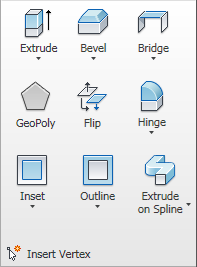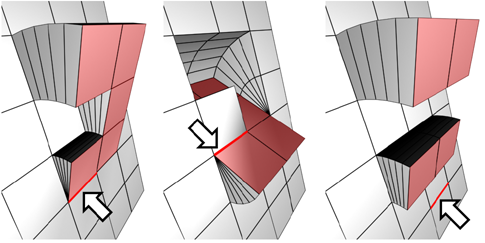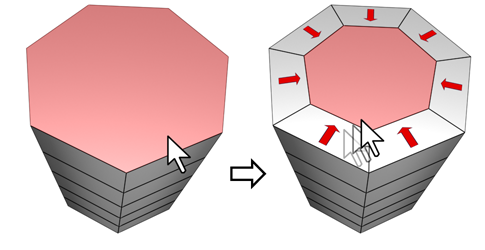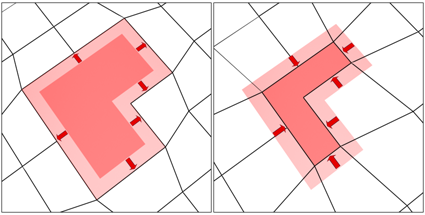A polygon is a closed sequence of three or more edges connected by a surface. Polygons provide the renderable surface of editable poly objects. An element is a group of contiguous polygons.
At the editable poly Polygon sub-object level you can select single and multiple polygons and transform them using standard
methods. At the Element sub-object level you can select and edit groups of contiguous polygons. For further distinctions between
polygon and element, see Editable Poly  Selection rollout.
Selection rollout.
The Polygons panel includes all of the following controls, while the Elements panel includes only the Flip and Insert Vertex functions.

 Extrude
Extrude
Lets you perform manual extrusion via direct manipulation in the viewport. Click this button, and then drag vertically on any polygon to extrude it.
Extruding polygons moves them along a normal and creates new polygons that form the sides of the extrusion, connecting the selection to the object.
Following are important aspects of polygon extrusion:

Chamfer box showing extruded polygon
Opens the Extrude Polygons caddy, which lets you perform extrusion via interactive manipulation.
If you click this button after performing an extrusion, the same extrusion is performed on the current selection as a preview and the dialog opens with Extrusion Height set to the amount of the last manual extrusion.
 Bevel
Bevel
Lets you perform manual beveling via direct manipulation in the viewport. Click this button, and then drag vertically on any polygon to extrude it. Release the mouse button and then move the mouse vertically to outline the extrusion. Click to finish.

Polygon beveled outward (left) and inward (right)
Opens the Bevel caddy, which lets you perform beveling via interactive manipulation.
If you click this button after performing a bevel, the same bevel is performed on the current selection as a preview and the dialog opens with the same settings used for the previous bevel.
 Bridge
Bridge
Connects two polygons or polygon selections on an object with a polygon “bridge.” There are two ways to use Bridge in Direct Manipulation mode (that is, without opening the Bridge Settings dialog):

Using Bridge at the Polygon level
Opens the Bridge Polygons caddy, which lets you connect pairs of polygon selections via interactive manipulation.
 GeoPoly
GeoPoly
 Flip
Flip
 Hinge
Hinge
Lets you perform a manual hinge operation via direct manipulation in the viewport. Make a polygon selection, click this button, and then drag vertically on any edge to hinge the selection. The mouse cursor changes to a cross when over an edge.

The hinge edge needn't be part of the selection. It can be any edge of the mesh. Also, the selection needn't be contiguous.
Hinging polygons rotates them about an edge and creates new polygons that form the sides of the hinge, connecting the selection to the object. It's essentially an extrusion with rotation, with the exception that, if the hinge edge belongs to a selected polygon, that side is not extruded. The manual version of Hinge From Edge works only with an existing polygon selection.
Opens the Hinge From Edge caddy, which lets you hinge polygons via interactive manipulation.
If you click this button after performing a manual hinge, the dialog opens with Angle set to the extent of the last manual hinge.
 Inset
Inset
Performs a bevel with no height; that is, within the plane of the polygon selection. Click this button, and then drag vertically on any polygon to inset it.

Inset works on a selection of one or more polygons. As with Outline, only the outer edges are affected.
Opens the Inset caddy, which lets you inset polygons via interactive manipulation.
If you click this button after performing a manual inset, the same inset is performed on the current selection as a preview and the dialog opens with Inset Amount set to the amount of the last manual inset.
 Outline
Outline
Lets you increase or decrease the outside edge of each contiguous group of selected polygons.

Outline is often used after an extrusion or bevel to adjust the size of the extruded faces. It doesn't scale the polygons; only changes the size of the outer edge. For example, in the following illustration, note that the sizes of the inner polygons remain constant.
Opens the Outline Polygons caddy, which lets you perform outlining by a numeric setting.
For details on using the caddy controls, see The Caddy Interface.
 Extrude on Spline
Extrude on Spline
Extrudes the current selection along a spline.

You can extrude a single polygon (1) or a selection of contiguous (2) or non-contiguous polygons (3). Extrusion 2 uses Taper Curve and Twist (available via Settings). Extrusion 3 uses Taper Amount; each extrusion has a different curve rotation.
Make a selection, click Extrude Along/On Spline, and then select a spline in the scene. The selection is extruded along the spline, using the spline's current orientation, but as though the spline's start point were moved to the center of each polygon or group.
Opens the Extrude Along Spline caddy, which lets you extrude along splines via interactive manipulation.
 Insert Vertex
Insert Vertex
Lets you subdivide polygons manually. Applies to polygons, even if at the element sub-object level.
After turning on Insert Vertex, click a polygon to add a vertex at that location. You can continue subdividing polygons as long as the command is active.
To stop inserting vertices, right-click in the viewport, or click Insert Vertex again to turn it off.
 Mirror Element X/Y/Z
Mirror Element X/Y/Z
 Mirror Element Clone
Mirror Element Clone